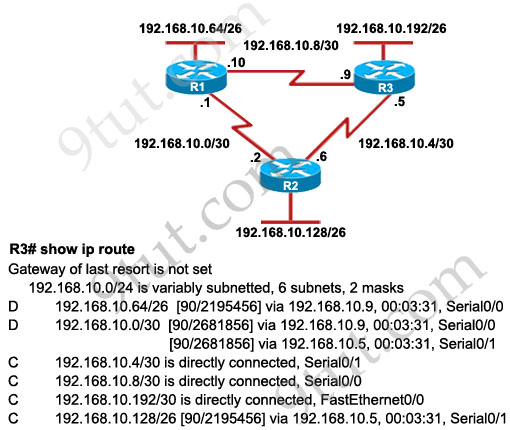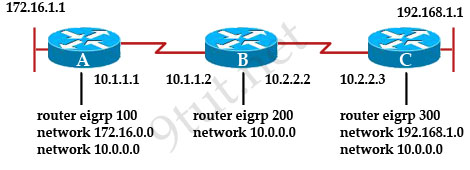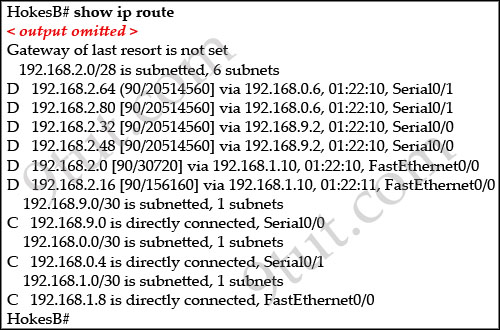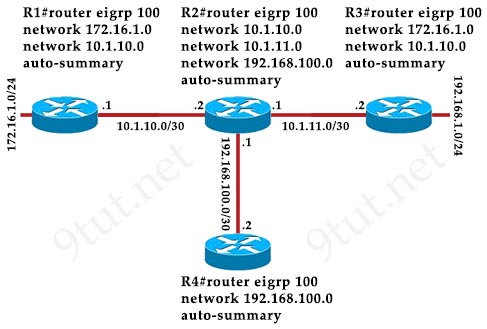ICND2 – EIGRP Questions
[am4show have=’p2;’]
Premium Member: You can test your knowledge with these questions first via this link.
[/am4show]
Question 1
[am4show have=’p2;’]Which EIGRP for IPv6 command can you enter to view the link-local addresses of the neighbors of a device?
A. show ipv6 eigrp 20 interfaces
B. show ipv6 route eigrp
C. show ipv6 eigrp neighbors
D. show ip eigrp traffic
Answer: C[/am4show]
Explanation
The “show ipv6 eigrp neighbors” command displays the neighbors discovered by the EIGRPv6. Notice that the neighbors are displayed by their link-local addresses.

Question 2
[am4show have=’p2;’]Refer to the exhibit. Based on the exhibited routing table, how will packets from a host within the 192.168.10.192/26 LAN be forwarded to 192.168.10.1?

A. The router will forward packets from R3 to R2 to R1
B. The router will forward packets from R3 to R1
C. The router will forward packets from R3 to R1 to R2
D. The router will forward packets from R3 to R2 to R1 AND from R3 to R1
Answer: D[/am4show]
Explanation
From the routing table we learn that network 192.168.10.0/30 is learned via 2 equal-cost paths (192.168.10.9 &192.168.10.5) -> traffic to this network will be load-balancing.
Question 3
[am4show have=’p2;’]Which option describes a difference between EIGRP for IPv4 and IPv6?
A. Only EIGRP for IPv6 advertises all connected networks.
B. Only EIGRP for IPv6 requires a router ID to be configured under the routing process
C. AS numbers are configured in EIGRP but not in EIGRPv3.
D. Only EIGRP for IPv6 is enabled in the global configuration mode.
Answer: B[/am4show]
Explanation
To configure EIGRP for IPv6 we must explicitly specify a router ID before it can start running. For example:
| ipv6 router eigrp 1 eigrp router-id 2.2.2.2 no shutdown |
Notice that EIGRP for IPv6 router-id must be an IPv4 address. EIGRP for IPv4 can automatically pick-up an IPv4 to use as its EIGRP router-id with this rule:
+ The highest IP address assigned to a loopback interface is selected as the router ID.
+ If there are not any loopback addresses configured, the highest IP address assigned to any other active interface is chosen as the router ID
EIGRPv3 also uses the AS number (for example: ipv6 eigrp 1 under interface mode).
Question 4
[am4show have=’p2;’]Refer to the exhibit. If the router R1 returns the given output and has not had its router ID set manually, what address will EIGRP use as its router ID?

A. 192.168.1.2
B. 172.16.4.1
C. 192.168.10.2
D. 1.1.1.1
Answer: D[/am4show]
Question 5
[am4show have=’p2;’]When running EIGRP what is required for RouterA to exchange routing updates with RouterC?

A. AS numbers must be changed to match on all the routers.
B. Loopback interface must be configured so a DR is elected.
C. The no auto-summary command is needed on Router A and Router C.
D. Router B needs to have two network statements, one for each connected network.
Answer: A[/am4show]
Explanation
We notice that 3 routers are using different AS numbers so they do not become neighbors and cannot exchange their routing updates. We need to choose only one AS number and use it on all 3 routers to make them exchange routing updates.
In this case we don’t need to use the “no auto-summary” command because network 10.0.0.0 is not separated by another major network.
Question 6
[am4show have=’p2;’]Refer to the exhibit. A packet with a source IP address of 192.168.2.4 and a destination IP address of 10.1.1.4 arrives at the HokesB router. What action does the router take?

A. forwards the received packet out the Serial0/0 interface
B. forwards a packet containing an EIGRP advertisement out the Serial0/1 interface
C. forwards a packet containing an ICMP message out the FastEthemet0/0 interface
D. forwards a packet containing an ARP request out the FastEthemet0/1 interface
Answer: C[/am4show]
Explanation
When a packet with destination IP address of 10.1.1.4 arrives at HokesB, it will look up in the routing table to find the most specific path. In this case no path is found so HokesB must inform to the source host that the destination is unreachable on the interface it has received this packet (it is Fa0/0 because the network 192.168.2.0/28 is learned from this interface). So the best answer here should be C – send an ICMP message out of Fa0/0.
Question 7
[am4show have=’p2;’]Refer to the exhibit. Given the output from the show ip eigrp topology command, which router is the feasible successor?
|
Router# show ip eigrp topology 10.0.0.5 255.255.255.255 IP-EIGRP topology entry for 10.0.0.5/32 State is Passive, Query origin flag is 1, 1 Successor(s), FD is 41152000 |
A.
10.1.0.3 (Serial0), from 10.1.0.3, Send flag is 0x0
Composite metric is (46866176/46354176), Route is Internal
Vector metric:
Minimum bandwidth is 56 Kbit
Total delay is 45000 microseconds
Reliability is 255/255
Load is 1/255
Minimum MTU is 1500
Hop count is 2
B.
10.0.0.2 (Serial0.1), from 10.0.0.2, Send flag is 0x0
Composite metric is (53973248/128256), Route is Internal
Vector metric:
Minimum bandwidth is 48 Kbit
Total delay is 25000 microseconds
Reliability is 255/255
Load is 1/255
Minimum MTU is 1500
Hop count is 1
C.
10.1.0.1 (Serial0), from 10.1.0.1, Send flag is 0x0
Composite metric is (46152000/41640000), Route is Internal Vector metric:
Minimum bandwidth is 64 Kbit
Total delay is 45000 microseconds
Reliability is 255/255
Load is 1/255
Minimum MTU is 1500
Hop count is 2
D.
10.1.1.1 (SerialO.1), from 10.1.1.1, Send flag is 0x0
Composite metric is (46763776/46251776), Route is External
Vector metric:
Minimum bandwidth is 56 Kbit
Total delay is 41000 microseconds
Reliability is 255/255
Load is 1/255
Minimum MTU is 1500
Hop count is 2
Answer: B[/am4show]
Explanation
First we must notice that all the 4 answers are parts of the “show ip eigrp topology” output. As you can see, there are 2 parameters in the form of [FD/AD] in each answer. For example answer C has [46152000/41640000], it means that the FD of that route is 46152000 while the AD is 41640000.
To become a feasible successor, a router must meet the feasibility condition:
“To qualify as a feasible successor, a router must have an AD less than the FD of the current successor route“
In four answer above, only answer B has an AD of 128256 and it is smaller than the FD of the current successor route (41152000) so it is the feasible successor -> B is correct.
Question 8
[am4show have=’p2;’]Which type of EIGRP route entry describes a feasible successor?
A. a backup route, stored in the routing table
B. a primary route, stored in the routing table
C. a backup route, stored in the topology table
D. a primary route, stored in the topology table
Answer: C[/am4show]
Explanation
Feasible successor is a route whose Advertised Distance is less than the Feasible Distance of the current best path. A feasible successor is a backup route, which is not stored in the routing table but stored in the topology table.
Question 9
[am4show have=’p2;’]What are the two default metrics used by EIGRP for route selection? (Choose two)
A. Bandwidth
B. Delay
C. Reliability
D. Load
E. MTU
Answer: A B[/am4show]
Explanation
The formula to caculate EIGRP metric is:
metric = [K1 * bandwidth + (K2 * bandwidth)/(256 – load) + K3 * delay] * [K5/(reliability + K4)]
By default, K1 = 1, K2 = 0, K3 = 1, K4 = 0, K5 = 0 which means that the default values use only bandwidth & delay parameters while others are ignored. The metric formula is now reduced to:
metric = bandwidth + delay
Note: But remember the bandwidth here is defined as the slowest bandwidth in the route to the destination & delay is the sum of the delays of each link.
Question 10
[am4show have=’p2;’]Refer to the exhibit.

Which three EIGRP routes will be present in the router R4’s routing table? (Choose three)
A. 172.16.1.0/24
B. 10.1.10.0/30
C. 10.0.0.0/8
D. 10.1.11.0/30
E. 172.16.0.0/16
F. 192.168.1.0/24
Answer: C E F[/am4show]


Why F is correct? R3 is not advertised that network right?
^ its on Q10….
Yeah, can anyone clarify question 10?
Yes, please provide explaination to question 10.
Q10.
10.0.0.0/8 – class A
172.16.0.0/16 – class B
192.168.1.0/24 – class C
Because auto-summary is enabled, eigrp will behave like a classful protocol.
Therefore only route with default mask will be shown in the routing table.
Q10 has to be messed up.
I built a test lab in GNS3 and tested myself
the answer should be
10.0.0.0/8
172.16.0.0/16
192.168.100.0/24 (not 192.168.1.0/24)
Q3
The exhibit have an error. Check the router link ip address identifiers (.10 .9 and .5 .6) the values are inverted accordingly with the routing table. 9tut need to do a better job this will confuse a lot of students.
can you please post the questions
192.168.100.0/24 should not be right because it is directly connected to R4, so it should have the symbol (C) instead of (D) EIGRP. I have not rebuild the LAB.
The question is explicitly about EIGRP (D) routes not just what routes will appear in the routing table.
Q10:
192.168.1.0/24 will not apppear in routing table because router is configured with “network 172.16.1.0”
So only 2 routes would appear in routing table, untill the network mistake is not fixed:
10.0.0.0/8
172.16.0.0/16
I totally agree with Derixin
You’re onto a winner Bryant.
For Q10
I have check with other resource and i found that the question has a mistake for R3
the correct entry for R3
R3#router eigrp 100
network 10.1.11.0
network 192.168.1.0
auto-summary
Can someone please explain Q10?
@Jay (explain Q10)
statement of “network 192.168.1.0” needs to be added to R3
for the answer selection to be correct for the question – EIGRP routes in R4’s routing table.
10.0.0.0/8, 172.16.0.0/16, 192.168.1.0/24
I was taking the ICND2 composite quiz #15 and got question #4, what IP would be chosen as the router ID and selected the answer that was for the loopback IP, 1.1.1.1 but the composite quiz marked it wrong. It said the correct answer is 192.168.1.2. Why would that be?
Per Cisco EIGRP uses the same manner to select the router ID as OSPF does, the highest IP assigned to a loopback interface is the router ID, if no loopback interface available then the highest IP assigned to any other interface is chosen.
hi all i will be want to ask if on ccna icnd2 exams would have a question where you have a question where you will have to configure ???
hi all sitting for my CCNA2 in November, can i have the latest Dump,email to releond at g.mail.co.m
eric s:
i see no reason why that isnt correct. Ospf and eigrp like to be ‘high’ (pick high numbers) starting with loopback (but STP picks ‘low’ at the ‘roots’)
Q10
A classful boundary of a class C address is of course 192.168.1.0 where the first 3 octets are represented. Here, the ‘1.0’ represents like a place holder, saying yes, in fact, because the classful boundary is a /24, we will represent that as the first possible IP 192.168.1.0. It is not necessarily saying ‘the route is 192.168.1.0’. It could IF WE WERE in NO AUTO SUMMARY, but since we are in auto summary, it doesnt matter if the route in question was 192.168.252.252 (for example) it would summarize into 192.168.1.0. Like “hey I dont care what you’ve got in your octets, just simplify this for me!” and so 252.252 would say “well, i guess we do belong to class C, after all, so ok, we’ll jump into the /24 pool with all the rest of the class C (auto-summarized addresses) and be represented as 192.168.1.0, because WE KNOW THOSE 3 octets must be represented, and the simplest/most efficient/first POSSIBLE way is 192.168.1.0
Anything? I just watched Vikings so I may be feeling conquestial…
It would be more cut and dry if, yes, R3 had the 192 listed instead of 172, i agree
Please correct me if Im wrong bc I need the study, too. Thanx all
9TUT
if thats right can I get a free month ?